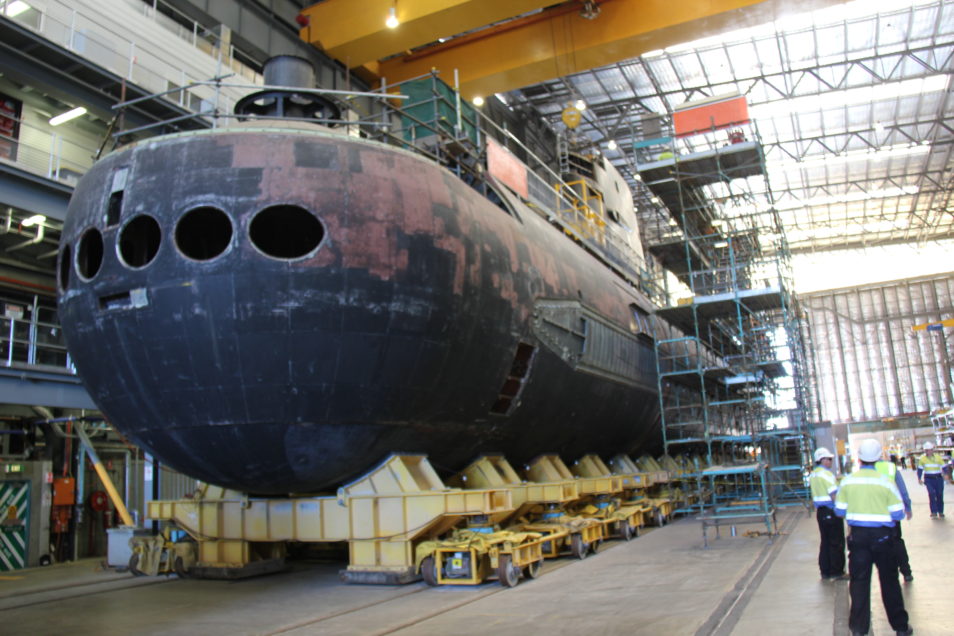
HMAS Rankin, sixth submarine of the Collins class, underway in 2006 Image: James R. Evans
HMAS Rankin, sixth submarine of the Collins Class. Image James R. Evans
When the navy have to repair a submarine they need to take them out of the water and out of action. We took a deep dive into the ocean blue, and our trail lead us back to dry land.
Sub-merge
There’s a reason the submarine branches of navies around the world are often known as the ‘silent service’. Subs can stealthily slip beneath the waves, performing a diverse range of missions. All while avoiding detection.
The Royal Australian Navy (RAN) Collins Class submarines can dive deep. They can also remain submerged just under the surface for almost 17000 kilometres. Long enough to make the trip from Sydney to Hawaii and back again.
They are difficult to detect, hard to predict and equipped with powerful weapons. So the RAN obviously wants to maximise availability of its six Collins Class subs. And reduce dry dock maintenance time wherever possible. But repairs and maintenance of these huge, expensive and complex machines takes considerable time. That’s where we come in. Welcome to the future of cold spray technology.

Collins Class submarine dry docked for maintenance at ASC facility in Osborne, South Australia. Image courtesy of ASC.
Submarine repair gets a supersonic solution
Cold spray is an additive manufacturing process. It works by accelerating metal particles at supersonic speed towards a surface. Without melting the metal, it builds up a dense deposit.
This technique offers some real advantages for the RAN. When they dive, submarines are subject to staggering pressures. If a submarine dives below the ‘crush depth’, the water pressure becomes too much and the submarine will implode. So keeping our submarines in excellent condition with the best-available maintenance method is key.
Cold spray forms part of the repair procedure for submarine components that have their metallic surfaces damaged, by adding metallic coatings without compromising structural integrity. It could also help Australian subs spend less time in dry dock and more time at sea. Currently when a submarine needs repair, it’s taken out of the fleet for maintenance. Being able to do in situ repairs will avoid such delays and boost the operational availability of these critical assets.
Honey I shrunk the cold spray
Cold spray is potentially the ideal and most efficient method for making repairs on submarines. As always though, there’s a catch. The use of cold spray is mostly in large component manufacturing and the current equipment takes up a lot of space. We’re working to change that.
At our Lab22 research facility in Melbourne, we’ll be developing further use cases for cold spray repair on submarine equipment. We’re also looking at how portable cold spray equipment can be used on submarines. This involves shrinking the system down to fit into confined spaces.
Meet the crew
We’re collaborating with Australian Submarine Corporation (ASC) and DMTC Limited — formerly known as Defence Materials Technology Centre.
ASC is responsible for the sustainment and maintenance of six Collins class submarines for the RAN. The company is well known for its innovation. And when they came to us for ideas on how to speed up repairs and maintenance, we dived right in. DMTC Limited has a long history in supporting the development of cold spray as a repair technology for a range of defence applications. Their involvement ensures further development of the technology over the next two years.
We’ve spearheaded the adoption of cold spray by Australian industry in recent years. For us, slipping below the briny deep with Collins Class subs is the culmination of almost 20 years of improving the technique. We can now use cold spray to provide coatings for electronics, anti-biofouling surfaces and titanium printing rollers.
This is just the start of cold spray’s development as a repair technology for defence applications. Cold spray has already proven itself as a means of manufacturing. Now, we can expand into the world of submarine repair.


15th June 2020 at 5:15 pm
Wow, I’m impressed
5th June 2020 at 11:11 am
Awesome technology, it looks promising. The article could be better edited for the understanding of the general public.
…and the music on the video ??♂️
5th June 2020 at 10:32 am
When you say “Just below the surface”, does that mean with the snorkel above the surface?